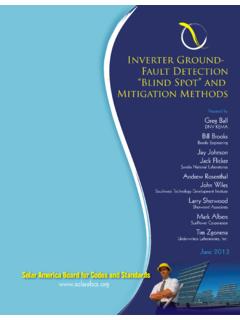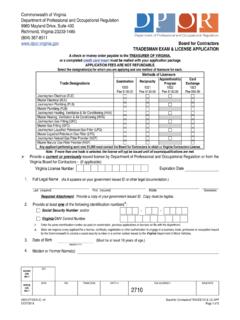Transcription of PV System Operations and Maintenance Fundamentals
1 PV System Operations and Maintenance Fundamentals Prepared by Josh Haney Adam Burstein Next Phase Solar. Inc. August 2013. Solar America Board for Codes and Standards DISCLAIMER. This report was prepared as an account of work sponsored by an agency of the United States government. Neither the United States government nor any agency thereof, nor any of their employees, makes any warranty, express or implied, or assumes any legal liability or responsibility for the accuracy, completeness, or usefulness of any infor- mation, apparatus, product, or process disclosed, or represents that its use would not infringe privately owned rights.
2 Reference herein to any specific commercial product, process, or service by trade name, trademark, manufacturer, or otherwise does not necessarily constitute or imply its endorsement, recommendation, or favoring by the United States government or any agency thereof. The views and opinions of authors expressed herein do not necessarily state or reflect those of the United States government or any agency thereof. Download a copy of the report: 2 Solar America Board for Codes and Standards Report EXECUTIVE SUMMARY. Until recently, the photovoltaics (PV) Industry has focused on the development of PV module technology, inverters, components, and manufacturing.
3 The United States now has more than gigawatts (GW) of installed capacity, comprising more than 300,000 systems (Sherwood, 2013). In light of this growth and the continued maturation of the PV market, the industry must focus on operating and maintaining systems. PV installation lifetimes are expected to be 25 years or more, so safe and proper Maintenance is an integral part of successful and reliable operation. System Operations and Maintenance (O&M) is a broad area, and is the continuing focus of several industry/ government/national laboratory working groups that are working to better define the issues and develop consensus approaches.
4 In the interim, the Solar America Board for Codes and Standards (Solar ABCs) has prepared an O&M introductory report that includes practical guidelines for PV System Maintenance and options for inspection practices for grounded PV systems. This report does not cover bi-polar, ungrounded, stand-alone, or battery backup systems. With the understandable focus on maximizing return on investment (ROI) and System production, System uptime is a key O&M objective. For example, inverters that are offline can have a dramatic negative impact on the ROI of a PV System . Inverter failure rates are important to ROI, but equally or even more important than how often an inverter goes offline is how quickly it can be placed back into service.
5 Diagnosing and correcting power production deficiencies is also important to maximizing availability of System components and ROI. This report includes the current, commonly used diagnostic and troubleshooting procedures for inverter malfunctions or failures and associated reduced power production. The intent of this report is to help qualified individuals maintain and inspect PV. systems safely. Qualification to conduct such inspections is earned by direct on- the-job training under qualified supervision or through training programs offered by accredited educational institutions or manufacturers.
6 It should be noted that many testing and Maintenance activities require two people to be performed safely and efficiently. Currently, an employee who is being trained for a task, demonstrates the ability to perform duties related to that task safely, and is under the direct supervision of a qualified person is usually considered to be a qualified person. This report also addresses currently known major safety requirements during PV. servicing and repair, including the proper use of lockout/tagout procedures, the use of personal protective equipment, procedures for safely disconnecting live circuits, and appropriate observation of and compliance with all PV-specific System signage and warnings.
7 In addition, it includes information about routine preventive Maintenance and emergency shutdown procedures. Newer PV systems may use devices that are not covered in this document, and technicians should contact the manufacturer for instructions on operating and maintaining such devices. This report also does not cover all the variations in equipment and measurement techniques that are available to qualified personnel, and there are suitable substitutes available for the equipment listed here. Readers should also be aware that PV systems are evolving to higher voltages, and voltmeters and other devices must be rated for use at the higher 1,000-volt level.
8 PV System Operations and Maintenance Fundamentals 3. Conclusions The conclusions of this introductory report include: To maintain quality control and safety standards, it is important that only qualified personnel work on PV installations. The authors suggest minimum skill and knowledge guidelines for PV technicians. Safety is a serious concern when servicing PV installations. Early PV systems often had maximum System voltages less than 50 Vdc, but 1,000 Vdc systems a re now allowed by code in commercial and large-scale installations. Qualified personnel should always work in teams of two people when working on live equipment, and there should always be at least two qualified persons trained in cardiopulmonary resuscitation on the jobsite.
9 Not all installations have appropriate signage, and qualified persons must be trained to recognize potential hazards with or without signage present. System uptime and availability is a key objective of O&M, and inverters that are offline can have a dramatic negative impact on the ROI of a PV System . Low power production also impacts ROI, and O&M personnel need effective strategies for identifying and correcting problems quickly. 4 Solar America Board for Codes and Standards Report AUTHOR BIOGRAPHIES. Josh Haney Next Phase Solar, Inc. Josh Haney is director of technical services at Next Phase.
10 Solar, Inc., which .. provides post-installation solar services focusing on Operations and Maintenance of existing photovoltaic (PV) arrays. He has more than two decades experience in the renewable energy field, and has installed, serviced, and managed the installation and Maintenance of both small- and large-scale solar systems total- ing more than 100 megawatts. He has also overseen the daily monitoring and Operations of commercial projects through data acquisition systems. In addition to being a North American Board of Certified Energy Practitioners (NABCEP) certified solar PV installer and a certified California journeyman electrician , he holds a Master of Business Administration with an emphasis in management from San Diego State University.





